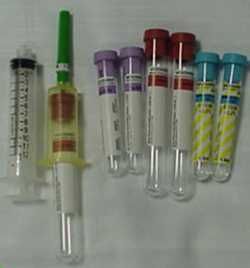Diagnostic Tests
When the tricky diagnosis of appendicitis is considered, blood tests and a urinalysis are required. The patient's blood is put into different colored tubes, each with its own additive depending on the test being performed:
- A purple-top tube is used for a complete blood count (CBC). A CBC measures: 1) The adequacy of your red blood cells, to see if you are anemic. 2) The number and type of white blood cells (WBCs), to determine the presence of infection. 3) A platelet count (platelets are a blood component necessary for clotting)
- A red-top tube is used to test the serum (the liquid or non-cellular half of your blood).
- A blue-top tube is used to test your blood's clotting.
The tests in your case indicate that you have an elevated WBC count. This is a sign of a bacterial infection, and bacterial infections are commonly associated with appendicitis.
Advertisement
At this point, the emergency physician may request that you not eat or drink anything. The reason is that appendicitis is treated by surgery, and an empty stomach is desirable to prevent some complications of anesthesia.
Diagnosis and Treatment
When the emergency physician has all the information he can obtain, he makes a determination of the most likely diagnosis from his differential diagnosis.
Alternately, he may decide that he does not have enough information to make a decision and may require more tests. At this point, he speaks to a general surgeon -- the appropriate consultant in this case. The surgeon comes to see you and performs a thorough history, physical exam, and review of your lab data. She examines your symptoms: pain and tenderness in the right, lower abdomen, vomiting, low-grade fever and elevated WBC count. These symptoms all point to appendicitis. The treatment of appendicitis is removal of the appendix, or an appendectomy. The surgeon explains the procedure, including the risks and benefits. You then sign a consent form to document this and permit her to operate on you.
